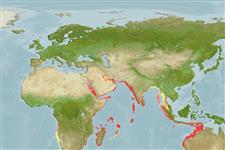Environment: milieu / climate zone / depth range / distribution range
Ecology
Marine; reef-associated; depth range 20 - 300 m (Ref. 28016). Tropical; 32°N - 28°S
Western Indian Ocean: Red Sea south to Mossel Bay, South Africa and east to India and Sri Lanka.
Length at first maturity / Size / Weight / Age
Maturity: Lm 34.6, range 35 - 45 cm
Max length : 75.0 cm TL male/unsexed; (Ref. 30573); common length : 30.0 cm TL male/unsexed; (Ref. 3507)
Found over rocky substrates of coastal waters. Juveniles stay in sheltered areas of estuaries (Ref. 5213). Large specimens caught from the shore only when seas are rough (Ref. 3198). Marketed fresh, whole or dried.
Also reported as a 'rudimentary hermaphrodite' or 'late gonochorist' where individuals posses an immature intersexual gonad but mature as either male or female fish with no eveidence of sexual reversal (Ref. 28504).
Bauchot, M.-L. and M.M. Smith, 1984. Sparidae. In W. Fischer and G. Bianchi (eds.) FAO species identification sheets for fishery purposes. Western Indian Ocean (Fishing Area 51). volume 4. [var. pag.] FAO, Rome. (Ref. 3507)
IUCN Red List Status (Ref. 130435)
Threat to humans
Harmless
Human uses
Fisheries: minor commercial
Tools
Special reports
Download XML
Internet sources
Estimates based on models
Preferred temperature (Ref.
123201): 17.8 - 27.7, mean 23.9 °C (based on 306 cells).
Phylogenetic diversity index (Ref.
82804): PD
50 = 1.0000 [Uniqueness, from 0.5 = low to 2.0 = high].
Bayesian length-weight: a=0.01380 (0.01217 - 0.01566), b=3.04 (3.01 - 3.07), in cm total length, based on LWR estimates for this species (Ref.
93245).
Trophic level (Ref.
69278): 3.5 ±0.4 se; based on diet studies.
Resilience (Ref.
120179): Low, minimum population doubling time 4.5 - 14 years (K=0.07-0.18; tmax=22).
Fishing Vulnerability (Ref.
59153): High vulnerability (60 of 100).
Climate Vulnerability (Ref.
125649): High vulnerability (60 of 100).
Nutrients (Ref.
124155): Calcium = 27.1 [12.9, 43.1] mg/100g; Iron = 0.467 [0.255, 0.927] mg/100g; Protein = 19.5 [18.2, 20.8] %; Omega3 = 0.149 [0.093, 0.244] g/100g; Selenium = 50.9 [25.2, 92.3] μg/100g; VitaminA = 68.3 [19.5, 227.4] μg/100g; Zinc = 1.07 [0.72, 1.50] mg/100g (wet weight);
